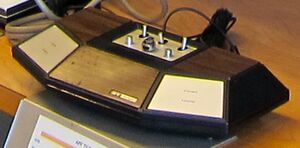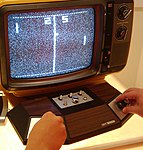Engineering:APF TV Fun
 APF TV Fun (model 442) | |
| Developer | APF Electronics Inc. |
|---|---|
| Manufacturer | APF Electronics Inc |
| Type | Dedicated console |
| Generation | First generation |
| Release date | Template:Vgy[1] |
| CPU | AY-3-8500 chipset from General Instruments[2] |
| Display | Vertical orientation, black-and-white raster display, standard resolution |
| Sound | Amplified mono (one channel) |
| Successor | APF-MP1000 |
The APF TV Fun is a series of early Pong clone consoles manufactured by APF Electronics Inc. and built in Japan starting in 1976. The systems were among the first built on the General Instrument 'Pong on a chip', the AY-3-8500, that allowed many manufacturers to compete against the Atari home pong.
The TV Fun package is the first excursion of APF into the video game market; APF was formerly a calculator and other small electronics developer. It was sold at Sears under the name Hockey Jockari. TV Fun was followed up by the 8 bit APF-MP1000 in 1978 and then APF Imagination Machine in 1979. These were made to compete in the 2nd generation of early ROM cartridge consoles, namely the Atari VCS.
Models
Most or all TV Fun consoles were manufactured in Japan. APF also sold a 'Match' system, which was in a different, more boxy woodgrain cabinet. This had two detachable wired controllers, based on the same General Instruments chip.
- The Model 401 and 401a features four built in games, a built in speaker, and two controller knobs, Toggle Switches (choices are "Professional" and "Amateur") for the following settings - Angle / Bat Size / Ball Speed. There are 2 buttons - Power and Start Game, and a dial to select between the four built-in games.[3]
- The Model 402 ("Sportsarama") features five built in games (Handball, Tennis, Hockey, Target Shoot, and Skeet Shoot). Of these, Handball and Tennis could be played in singles or doubles mode, and Hockey could be played in 2- or 4-player mode. Along with the two on-console analog controller knobs introduced with the 401, the 402 also includes two wired controllers and a black plastic light gun. The 402 has different options than the 401, lacking the angle/bat size/ball speed, but adding in options for 4-player games, a manual or auto serve, a serve button, and light gun functionality. Digital scoring up to 21 points appears on screen, and the system offers color visuals. As with the 401, the 402 model is built in a faux woodgrain cabinet, and can be powered by an AC adapter or by using six C size batteries.[3][4]:24
- The Model 405 features three two-person games (Tennis/Table Tennis, Hockey/Football, and Squash), and a solo-play version of Handball. The 405 includes two wireless controllers and offers players three different skill settings (amateur, average, and professional) and a choice between an automatic or manual serve. Digital scoring up to 15 points appears on screen. As with prior models, the 405 can be powered by an AC adapter or by using six C size batteries.[4]:21[5]:34
- The Model 406 is the color television version of the 405. It features the same three two-person games (Tennis, Hockey, and Squash), and the solo-play Handball. The 406 has the same options and settings as the 405, and the same point total (15 points). The 406 can be powered by an AC adapter or by using six C size batteries.[5]:35
- The Model 442 features five games: Tennis/Ping Pong, Hockey, Football, Singles Handball, and Squash. The 442 provides an automatic serve function and offers two different skill settings (amateur and professional) that adjust paddle size, ball speed, and angle of deflection. Digital scoring up to 15 points appears on screen. The 442 can be powered by an AC adapter or by using six C size batteries.[4]:21
- The Model 444 features four games (Tennis, Hockey, Singles Handball, and Squash) with up to eight setting variations possible. The 444 provides an automatic serve function and offers both amateur and professional skill settings that adjust paddle size, ball speed, and angle of deflection. Digital scoring up to 15 points appears on screen. The 444 can be powered by an AC adapter or by using six C size batteries.[4]:22
- The Model 500 (unreleased) features twenty different two-player space battle games including Space War, Space Phasor, Phantom War, and Phantom Phasor among others. The 500 includes two wireless controllers used to guide spaceships and launch missiles. On-console controls allow players to adjust asteroid speed and phantom rocket density to match player' skill levels. Digital scoring up to 20 points appears on screen, with a blinking "W" symbol indicating when the players have won the game. The system offers color visuals, and is powered by six C size batteries or an AC adapter.[4]:26
References
- ↑ Video games. Put your backhand on TV, By Cindy Morgan, Popular Mechanics, Oct 1976, Page 80, Picture and listed in table: ...APF TV Fun / Price: $90 / Number of Players: 1-2 / .../ Color: no / ... / Remarks: Manual or auto-serve; ball angle selection...
- ↑ "Museum: APF TV Fun (Model 401)". Old-Computers.com. http://www.old-computers.com/museum/computer.asp?c=1009&st=1. Retrieved 2012-03-29.
- ↑ 3.0 3.1 "APF TV Fun (#401A)". Vidgame.net. 2008-07-05. Archived from the original on July 5, 2008. https://web.archive.org/web/20080705030041/http://www.vidgame.net/PONG/apf_fun.htm. Retrieved 2012-03-29. (Archived via Internet Archive Wayback Machine)
- ↑ 4.0 4.1 4.2 4.3 4.4 Kaplan, Deeny, ed (Winter 1978). "The Video Games". Video (Buyer's Guide) (Reese Communications) 1 (1): 17–30. ISSN 0147-8907.
- ↑ 5.0 5.1 Kaplan, Deeny, ed (Winter 1979). "Video Games". Video (Buyer's Guide) (Reese Communications) 2 (1): 33–42. ISSN 0147-8907.


